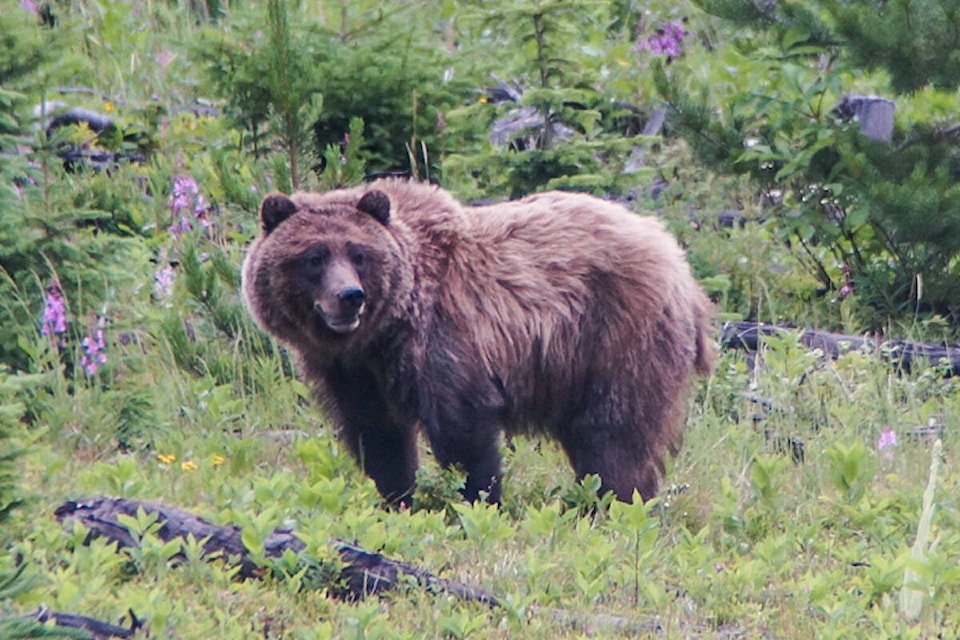How might we better co-exist with the grizzly bears who make the Elk Valley their home?
The Hosmer Community Hall was filled with people Wednesday (May 25) evening to hear a presentation on that question and more.
The talk was given by Gillian Sanders of Grizzly Bear Solutions and University of British Columbia biologist Clayton Lamb.
“We have abundant grizzly bear populations in the Elk Valley,” Lamb said.
“But with a lot of bears come, actually, a number of conflicts that we see in the valley.”
There is property damage, and people not feeling safe around bears, he said. The challenge is trying to find a balance, where bears can live in the valley and people can still feel safe.
There have been two recent conflictual bear encounters around Fernie, one that led to a dog being injured (it was not confirmed whether the bear was a grizzly in that case), and another that led to a grizzly being shot and killed.
READ MORE: Grizzly bear shot and killed near Fernie, COs seeking information
READ MORE: Bear encounter near What’s Up Doc trail in Fernie leaves dog with injuries
“Part of the challenge for grizzly bears in the valley is really high mortality rates,” Lamb said.
According to Lamb (based on the DNA mark-recapture method), there are about 150 to 200 grizzlies in the Elk Valley region.
The mortality rate for adult bears is ‘fairly typical,’ he said, and hovers around 5 and 8 per cent a year.
Young bears, on the other hand, have a steep learning curve and a much lower chance of survival.
Lamb said that young males can have about a 50 per cent mortality rate per year at times, while young females are around 30 per cent a year.
Collisions on the highway and with trains and conflicts in town all contribute to the high mortality rate, Lamb said.
“All that together… basically means that we have one of the highest mortality rates of young bears in British Columbia.”
Elaborating on the phenomenon, he said: “They’re young bears that aren’t very savvy, and so that itself makes the Elk Valley more conflict prone.
“If we could have a population of bears that were able to survive for a few years, and understand how to live in the valley, we would actually see conflict go down,” he said, adding that the young ones have a sort of naiveté.
Sanders said that finding solutions for co-existence means thinking about how to prevent conflicts, how humans can stay safe near bears, and how to protect property, livestock and agricultural attractants from the wild animals.
According to Lamb, evidence-based tools that help people co-exist with grizzly bears are electric fencing and bear spray. Removing fruit trees from property also helps.
Lamb said: “The one thing we know is that electric fencing works very well for deterring grizzly bears from attractants.”
Sanders said: “Carry bear spray and know how to use it.”
The primary reasons bears can become defensive are for their cubs, for a food source or carcass, or for personal space, Sanders said.
“You do not want to wear ear buds if you’re out hiking or biking, be aware of your surroundings. If you see birds of prey, ravens or carrion birds circling, don’t go there, there could be a carcass, avoid that.”
Dogs off leash can also be a hazard around bears, potentially aggravating and attracting the wild animals into human encounters that might have otherwise been avoided.
Sanders and Lamb have worked together on a cost-share program that loosely covers half the cost of things like electric fencing and fruit tree removal and replacement.
“We’re trying to see what tools we can provide to people to make the landscape work better for them and for the bears of the Elk Valley,” Lamb said.
Funding for the program comes from Teck, the Habitat Conservation Trust Foundation, and the Yellowstone to Yukon Conservation Initiative. The contact point for people who are interested in the program is WildsafeBC, Lamb said.
Sanders asked: “We and the bears are here on the landscape at the same time, and what does that mean?”
“It means how do we live our lives, raise our kids, raise our food, without conflicts with bears, and how do bears do the same.”
For more information on this topic, contact Sanders at grizzlybearsolutions@gmail.com.
READ MORE: Bears start foraging in the Elk Valley for 2022
READ MORE: A tough year for bears in the Elk Valley: Dozens euthanized, more killed in collisions
READ MORE: BC Conservation needs oversight on bear euthanizations, expert argues
@fishynewswatch
josh.fischlin@thefreepress.ca
Like us on Facebook and follow us on Twitter.
